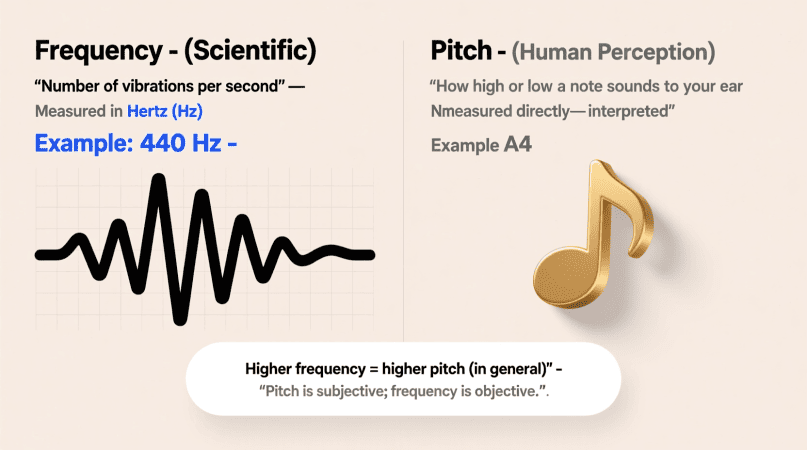
If you’ve ever wondered why a singer’s note can sound “off” even when a tuner says they’re on the right frequency, you’ve already stumbled into the debate of pitch vs frequency. The two terms are related, but they’re not the same.
One is a scientific measurement, while the other is a human perception. Understanding the difference helps musicians, audio engineers, and even physics students make sense of sound.
Try Our: free pitch detector
Try Our: note to frequency converter
Quick Answer: Pitch vs Frequency
- Frequency is the scientific measurement of sound waves, counted in Hertz (Hz) — the number of vibrations per second.
- Pitch is how our ears and brain interpret that frequency as a musical note, such as A4 or C♯.
| Aspect | Frequency | Pitch |
|---|---|---|
| Definition | Number of sound wave vibrations per second | Human perception of frequency as “high” or “low” |
| Unit | Measured in Hertz (Hz) | No unit, described as notes (A, C♯, etc.) |
| Objective / Subjective | Objective, same for everyone | Subjective, varies with hearing ability |
| Example | A4 = 440 Hz | The sound we recognize as “concert A” |
What is Frequency?
Frequency is the scientific backbone of sound. Every sound wave vibrates, and the faster it vibrates, the higher its frequency. For example:
- Low frequencies: 60 Hz → the deep rumble of bass.
- Mid frequencies: 440 Hz → the standard A4 used to tune instruments.
- High frequencies: 5,000 Hz → the bright chirp of a bird.
Think of frequency as the raw data of sound. It doesn’t care if it feels high, low, warm, or shrill — it’s just numbers.
What is Pitch?
Pitch is how our brain interprets frequency. When you hear a note and describe it as “high” or “low,” you’re talking about pitch. But here’s where it gets interesting: pitch is not always perfectly aligned with frequency.
- Two people can hear the same frequency but perceive the pitch differently, especially if one has hearing loss or musical training.
- At extremely low or high frequencies, pitch becomes harder for humans to distinguish.
So while frequency is absolute, pitch is relative to perception.
Key Differences Between Pitch and Frequency
- Frequency is objective; pitch is subjective.
- Frequency is measured in Hertz; pitch has no physical unit.
- Frequency exists even without humans; pitch requires a human ear and brain.
- Frequency can be identical, yet pitch may differ due to perception.
Real-World Examples
- Tuning an instrument: A tuner measures 440 Hz, but a violinist might feel the pitch sounds slightly sharp compared to another instrument.
- Audio mixing: Engineers adjust frequencies with EQ, but they talk about pitch when aligning vocals or instruments.
- Daily life: An ambulance siren sounds like its pitch changes as it passes by — but in reality, the frequency is shifting due to the Doppler effect.
Common Misconceptions
- “Pitch and frequency are the same thing.” → They are related but not identical.
- “Higher frequency always means higher pitch.” → At extreme ranges, the ear doesn’t perceive pitch linearly.
- “Everyone hears pitch the same way.” → Age, hearing health, and training all affect pitch perception.
Why Understanding Pitch vs Frequency Matters
- For musicians: Helps with tuning, harmony, and ear training.
- For audio engineers: Essential for mixing clarity and balancing tracks.
- For scientists: Important in acoustics, hearing tests, and sound design.
- For everyday listeners: Explains why two people may disagree if a note is “too sharp” or “too flat.”
FAQs
1. Is pitch the same as frequency?
No. Frequency is measurable in Hz; pitch is how humans interpret that frequency.
2. What is the unit of pitch?
Pitch has no physical unit; it’s described as notes (A, C♯, etc.).
3. Can two sounds with the same frequency have different pitches?
Yes, depending on context, overtones, and how humans perceive the sound.
4. Why do older people hear pitch differently?
Age-related hearing loss reduces sensitivity to high frequencies, altering pitch perception.
5. How does pitch vs frequency matter in music?
Musicians tune by frequency but judge their performance by pitch perception.
Final Takeaway
The difference between pitch and frequency is simple: frequency is science, pitch is perception. Frequency tells us how fast sound waves vibrate, while pitch tells us how we interpret those vibrations as music.
Whether you’re a student, musician, or audio engineer, knowing this distinction sharpens both your technical understanding and your creative work.
👉 Want to analyze your own voice frequencies and pitch? Try the Voice Pitch Analyzer to see how science and perception meet in real time.
Pitch Detector is a project by Ornella, blending audio engineering and web technology to deliver precise, real-time pitch detection through your browser. Designed for musicians, producers, and learners who want fast, accurate tuning without installing any software.
